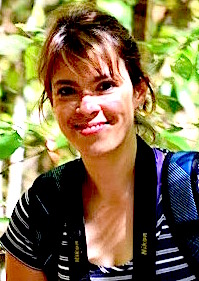
Figures 1-7. Stomatal development. 1-4. Median third of leaf blade of Vellozia epidendroides. 5. Proximal third of leaf blade of Nanuza plicata. 6. Median third of leaf blade of Barbacenia riparia. 7. Proximal third of leaf blade of Vellozia glauca. (0 = GMC; 01 = guard cell; 1 = neighbour cell; 11 = neighbour cell’s daughter; 12 = trapezoid cell; 13 = trapezoid cell’s daughter; 2 = polar cell, 21 = polar cell’s daughter; * unclear situations). Bar = 2.5 μm.
Ontogenesis of stomata in Velloziaceae: paracytic versus tetracytic?
A ontogênese dos estômatos em Velloziaceae: paracítico versus tetracítico?
by Amaral M. M., Mello-Silva R. (2008)
Universidade de São Paulo, Instituto de Biociências, Caixa Postal 11461, 05422-970 São Paulo, SP, Brazil

Marina Milanello do Amaral;

Renato de Mello-Silva
in Revta bras. Bot. 31. 529-536. – http://dx.doi.org/10.1590/S0100-84042008000300016 –
www.scielo.br/pdf/rbb/v31n3/a16v31n3.pdf
http://www.scielo.br/scielo.php?script=sci_arttext&pid=S0100-84042008000300016 –
Vellozia (3 spp.), Barbacenia. LM – stomata, epidermis, leaf ts.

Figures 8-13. Influence of area on stomatal configuration. 8-10. Barbacenia riparia. 11-13. Nanuza plicata. 8 and 11. Transversal section of the median region of leaf blades, furrows absent. 9. Stoma with cells type 2 or 21 (2*) similar to other epidermal cells. 10. Stoma with short cells type 2 or 21 (2*) similar to the closest epidermal cells. 12. Variation in size and shape of cells type 2 or 21 (2*). 13. Stomata surrounded by more than four cells and inserted between rows of needle-like epidermal cells. (01 = guard cell; 13 = subsidiary cell; 2* = polar cell). Bar = 100 μm (8, 11), 5 μm (9-10, 12-13).
ABSTRACT
In Velloziaceae, the number of subsidiary cells has been used to characterize species and support groups. Nevertheless, the homology of the stomatal types have not been scrutinized.
Stomatal ontogenesis of Vellozia epidendroides and V. plicata, assigned to have tetracytic stomata, and of V. glauca and Barbacenia riparia, assigned to have paracytic stomata, were investigated.

Figures 14-19. Influence of area on stomatal configuration. 14-16. Vellozia epidendroides. 17-19. Vellozia glauca. 14 and 17. Transversal section of leaf blades, showing furrows. 15. Inter-furrows area showing only cells type 13, which are distinct from ordinary epidermal cells, and variation in size and shape of cells type 2 or 21 (2*). 16. Furrow area showing short cells type 2 or 21 (2*). 18. Inter-furrows area at centre, showing long cells type 2 or 21 (2*) surrounded by ordinary long epidermal cells, and furrow area, at right, showing short cells type 2 or 21 (2*) surrounded by ordinary short epidermal cells. 19. Furrows area showing short cells type 2 or 21 (2*) surrounded by ordinary short epidermal cells. (01 = guard cell; 13 = subsidiary cell; 2* = polar cell). Bar = 150 μm (14), 10 μm (15, 18 and 19), 2.5 μm (16), 100 μm (17).
In the four species studied, stomata followed perigenic development. Subsidiary cells arise from oblique divisions of neighbouring cells of the guard mother cell (GMC). These cells are elongated and parallel to the longer axis of the stoma. Polar cells show wide variation, following the shape and size of the epidermal cells in the vicinity. Hence, these cells cannot be called subsidiary cells.
This wide variation is due to a much higher density of stomata in some regions of the leaf blade. This distribution of stomata forces the development of short polar cells, leading to an apparently tetracytic stomata.
In regions of low concentration of stomata, higher spatial availability between the GMCs allows the elongation of polar cells, leading to evident paracytic stomata.
Therefore, the four studied species are considered braquiparacytic, questioning the classification of stomata into tetracytic and paracytic in Velloziaceae.